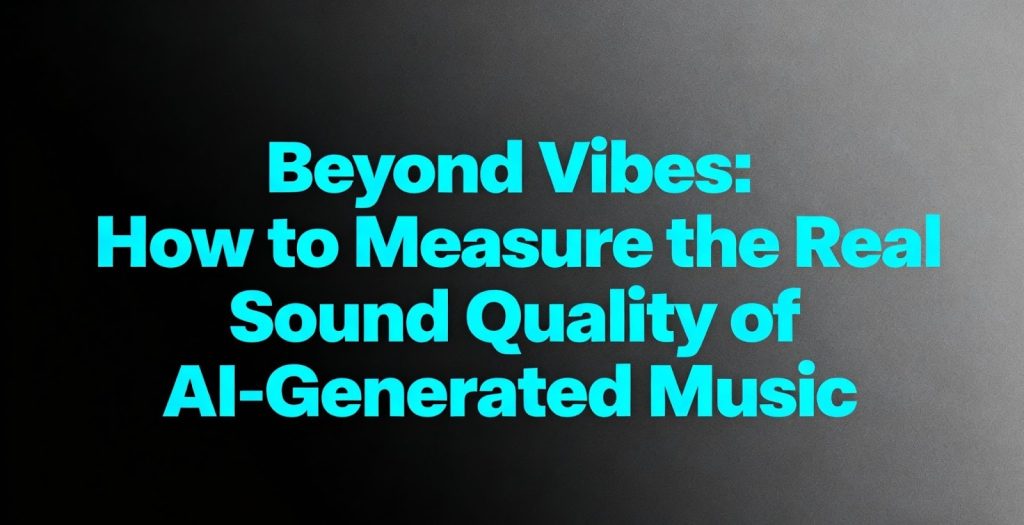Accurately measuring sound quality in AI-generated music demands a blend of objective metrics, perceptual evaluation, and industry benchmarks to move beyond surface-level vibes. Musicians and producers often struggle to quantify fidelity, clarity, and listener engagement when algorithms compose melodies. This guide promises actionable methods to evaluate audio quality benchmarks across technical measurements, listening tests, benchmarking datasets, AI-specific challenges, supporting tools, and future trends. Readers will explore:
- Core objective metrics such as signal-to-noise ratio, dynamic range, and frequency response
- Perceptual assessment through listening tests, psychoacoustic models, and user feedback
- Benchmarking practices with datasets and industry protocols
- AI-versus-traditional evaluation differences and the limitations of current metrics
- Practical tools and strategies—including leveraging AI music platforms—to refine output
- Artist workflows for iterative quality improvement
- Emerging trends shaping next-gen fidelity measurement
By weaving objective analysis with perceptual insight, this article builds a holistic framework for anyone using audio quality benchmarks to elevate AI-generated productions.
What Are the Key Metrics for Objective AI Audio Evaluation?
Objective AI audio evaluation defines measurable properties of sound that link directly to fidelity and transparency. These metrics function as engineering benchmarks to compare different AI models and synthesis techniques under consistent conditions. For example, quantifying noise levels and spectral balance reveals model strengths and weaknesses before human listeners weigh in. Adopting standardized metrics ensures reproducibility and clarity in assessing audio quality benchmarks across diverse AI music generators, including emerging creative platforms.
Which AI Music Fidelity Metrics Best Reflect Audio Quality?

Fidelity metrics evaluate how closely AI-generated audio matches a reference signal, ensuring clarity and detail in the final mix.
- Perceptual Evaluation of Audio Quality (PEAQ) measures perceived audio distortion through psychoacoustic modeling.
- Log-Spectral Distance (LSD) quantifies spectral envelope differences between reference and output.
- Mel-Cepstral Distortion (MCD) assesses timbral accuracy by comparing mel-cepstrum coefficients.
Each metric links algorithmic output to human hearing models, enabling engineers to prioritize improvements that align with listener expectations and reduce unwanted artifacts.
Evaluating AI-Generated Music: Subjective, Objective, and Combined Methodologies
The survey aims to comprehensively evaluate the subjective, objective, and combined methodologies for assessing AI-generated music. It also discusses the challenges and future directions in the field, including the need for standardized evaluation protocols and the development of more sophisticated metrics that can capture the nuances of musical quality. The paper reviews existing datasets and benchmarks used for AI music evaluation, highlighting their strengths and limitations. Furthermore, it explores the differences between human and AI evaluation of music, considering factors such as creativity, emotional impact, and cultural context. The survey also touches upon the ethical implications of AI-generated music and its potential impact on the music industry. A comprehensive survey for evaluation methodologies of ai-generated music, Z Xiong, 2023
How Do Signal-to-Noise Ratio and Distortion Affect AI Music Quality?
Signal-to-noise ratio and distortion capture unwanted artifacts and clarity in AI compositions. A higher signal-to-noise ratio indicates cleaner audio, while lower distortion values reflect faithful reproduction of the intended signal.
| Metric | Definition | Impact on Quality |
|---|---|---|
| Signal-to-Noise Ratio (SNR) | Ratio of desired signal level to background noise | Higher SNR yields clearer mixes with less hiss |
| Total Harmonic Distortion | Percentage of unwanted harmonics relative to tone | Lower distortion preserves instrument timbre |
Maintaining an SNR above 80 dB and THD under 0.1% guides AI developers toward cleaner, more transparent outputs. These parameters form the backbone of audio quality benchmarks for machine-generated tracks.
What Role Do Dynamic Range and Frequency Response Play in AI Audio?
Dynamic range and frequency response define the expressive depth and spectral balance of AI music. Dynamic range measures the loudness difference between the quietest and loudest passages, supporting impact and nuance. Frequency response charts how evenly AI synthesis covers bass, midrange, and treble frequencies, ensuring no band is overly attenuated or exaggerated. Maintaining a wide dynamic range (>60 dB) and flat response from 20 Hz to 20 kHz delivers productions that translate reliably across playback systems and listener environments.
How Can Perceptual Sound Quality Be Assessed in AI-Generated Music?
Perceptual assessment translates technical audio benchmarks into human listening experiences by using structured tests and psychoacoustic insights. This approach grounds objective metrics in acceptability thresholds, guiding AI creators toward outputs that resonate with target audiences. Integrating perceptual sound quality ensures AI-generated tracks not only measure well on paper but also engage listeners with clarity and emotional impact.
What Are Common Perceptual Evaluation Methods for AI Music?
Perceptual evaluation methods involve controlled listening sessions and standardized scales that capture subjective impressions.
- Mean Opinion Score (MOS) surveys ask listeners to rate clarity, naturalness, and overall quality on a numerical scale.
- Double-blind ABX tests determine if listeners can distinguish AI output from human-produced audio.
- Semantic Differential Scales measure attributes such as warmth, brightness, and depth.
These methods translate listener feedback into actionable scores, anchoring audio quality benchmarks to perceptual relevance.
Meta-Methodology for User Evaluation of AI-Generated Music
This paper proposes a meta-methodology for user evaluation of artificial intelligence generated music. It introduces a framework that combines the Analytical Hierarchy Process (AHP), Likert scales, and emotional state estimations to provide a more holistic assessment of AI music. The methodology aims to capture both objective and subjective aspects of music quality, including aspects like coherence, novelty, and emotional resonance. The study also reviews existing evaluation methods for AI music, such as Mean Opinion Score (MOS) studies, and discusses their limitations. The proposed meta-methodology is validated through a user study, demonstrating its effectiveness in providing reliable and comprehensive evaluations of AI-generated music. A Meta-Methodology for User Evaluation of Artificial Intelligence Generated Music; Using the Analytical Hierarchy Process, Likert and Emotional State Estimations, M Civit, 2025
How Do Listening Tests and User Feedback Influence AI Music Quality Scores?
Listening tests and user feedback inject real-world validation into AI audio evaluation by revealing preferences and perceptual thresholds. In structured trials, diverse listener groups assess mixes in varying environments, highlighting model artifacts or tonal imbalances. Aggregated feedback scores then inform iterative model retraining, steering AI systems toward improved clarity and emotional resonance. By prioritizing genuine listener responses, developers anchor audio quality benchmarks in genuine audience expectations.
Which Psychoacoustic Models Help Measure Perceptual Sound Quality?
Psychoacoustic models link physical audio parameters to human perception, creating more meaningful benchmarks. Models such as the Perceptual Evaluation of Speech Quality (PESQ) and the ITU-R BS.1387 framework consider masking effects, loudness, and distortion audibility. Integrating these algorithms into evaluation pipelines aligns AI-generated music quality scores with hearing sensitivity and temporal masking phenomena. This approach ensures technical improvements translate into perceptual gains.
What Are the Best Practices for Benchmarking AI-Generated Audio?
Benchmarking AI audio involves comparing model outputs against reference datasets and established industry standards, ensuring continuous performance monitoring. Structured benchmarks reveal strengths and weaknesses across synthesis techniques, sample rates, and model architectures. By following best practices, AI music developers build credibility and track progress through quantifiable audio quality benchmarks.
How Are Benchmark Datasets Used to Compare AI Music Quality?
Benchmark datasets comprise curated audio samples spanning genres, instruments, and production styles to ensure broad evaluation coverage. Researchers use datasets such as MUSDB18 or proprietary multitrack stem collections to test AI systems under realistic conditions. Each AI output is compared against high-quality references using objective metrics and listening tests. This structured comparison identifies model generalization gaps and guides improvements across diverse musical contexts.
What Standards and Protocols Exist for AI Audio Benchmarking?
Industry bodies and research communities publish protocols such as ITU-R BS.1387 and AES-SC-02 for audio measurement and format consistency. These standards define test signal generation, measurement setups, and reporting formats for frequency response, distortion, and noise. Adhering to these guidelines fosters reproducibility and comparability across research labs and commercial labs. Consistent protocols underpin reliable audio quality benchmarks in AI music evaluation.
How Do Benchmark Results Guide AI Music Model Improvements?
Benchmark results highlight model performance across objective and perceptual dimensions, indicating which aspects require refinement. Low frequency response linearity might prompt filter redesign, while elevated distortion flags encoder modifications. By aligning development priorities with benchmark outcomes, AI teams allocate resources to impactful improvements. This feedback loop ensures continuous enhancement of fidelity and realism in AI-generated music.
How Does AI Music Quality Assessment Differ from Traditional Audio Evaluation?
AI-generated music introduces unique artifacts and statistical synthesis behaviors that differ from human recordings, demanding specialized evaluation strategies. Traditional audio assessment focuses on equipment and recording chain performance, while AI evaluation must consider model architecture, training data biases, and algorithmic interpolation artifacts. Recognizing these differences ensures audio quality benchmarks accurately reflect AI-specific challenges in synthesis and postprocessing.
What Unique Challenges Does AI-Generated Music Present for Quality Measurement?
AI outputs often exhibit spectral blurring, phase inconsistencies, and sample-level noise patterns absent in acoustic recordings. These artifacts require specialized detection algorithms and listening conditions to identify. Additionally, model overfitting can yield lifeless, repetitive passages, impacting listener engagement. Benchmarking must therefore include tests for timbral diversity and temporal coherence to capture these AI-specific quality issues.
How Do AI Models Influence Sound Quality Compared to Human Composers?

AI models synthesize music by predicting sample sequences based on training data statistics, while human composers impart intentional dynamics and expressive timing. This statistical approach can yield novel textures but sometimes sacrifices musical phrasing and microtiming nuances. Evaluating AI music for both technical fidelity and expressive authenticity ensures that audio quality benchmarks encompass both precision and artistic feel, bridging the gap between algorithmic generation and human creativity.
What Are the Limitations of Current AI Music Quality Metrics?
Existing metrics often focus on static properties like spectral distance or loudness without fully capturing musicality and emotional impact. Metrics such as MCD or PEAQ do not account for phrase-level structure or harmonic progression quality. As a result, high technical scores can coincide with unengaging or unnatural output. Evolving benchmarks to incorporate structural and expressive measures remains a key priority for next-generation audio quality benchmarks.
Comprehensive Survey of AI-Generated Music Evaluation Methodologies
The survey aims to comprehensively evaluate the subjective, objective, and combined methodologies for assessing AI-generated music. It also discusses the challenges and future directions in the field, including the need for standardized evaluation protocols and the development of more sophisticated metrics that can capture the nuances of musical quality. The paper reviews existing datasets and benchmarks used for AI music evaluation, highlighting their strengths and limitations. Furthermore, it explores the differences between human and AI evaluation of music, considering factors such as creativity, emotional impact, and cultural context. The survey also touches upon the ethical implications of AI-generated music and its potential impact on the music industry. A comprehensive survey for evaluation methodologies of ai-generated music, Z Xiong, 2023
Which Tools and Technologies Support AI Music Fidelity Metrics?
A variety of software and machine learning frameworks automate the extraction and analysis of audio quality benchmarks, streamlining evaluation workflows. These tools integrate signal processing libraries and psychoacoustic models to deliver comprehensive reports on fidelity, noise, and perceptual scores. By leveraging these technologies, creators can iterate faster and maintain consistent quality standards across AI compositions.
What Software Solutions Are Available for AI Audio Quality Analysis?
Leading solutions include open-source libraries like LibROSA and Essentia, which offer spectral, temporal, and perceptual feature extraction. Commercial platforms integrate automated reporting dashboards that visualize SNR, THD, frequency response, and PEAQ scores. These tools often support batch processing of multitrack stems, enabling large-scale benchmarking of model outputs. Adopting a robust analysis suite allows teams to quantify performance and track improvements over time.
How Do Machine Learning Models Assist in AI Music Quality Assessment?
Supervised ML models trained on annotated datasets can predict perceptual scores directly from audio waveforms, accelerating evaluation cycles. Neural networks map spectral and temporal features to listener ratings, providing real-time quality feedback during generation. These predictive models reduce reliance on manual listening tests and streamline the optimization loop for AI music systems, ensuring fidelity improvements align with perceptual benchmarks.
Can Real-Time Monitoring Improve AI-Generated Music Sound Quality?
Yes, real-time monitoring systems embed quality checkpoints within production pipelines, analyzing audio as it is synthesized. Live dashboards alert developers to out-of-range SNR, clipping, or masking issues immediately, allowing on-the-fly adjustments to model parameters. This proactive approach ensures that audio quality benchmarks are upheld from the first sample to final export, reducing revision cycles and preserving creative momentum.
How Can Artists and Producers Use AI Music Quality Insights?
Artists and producers translate audio quality benchmarks into actionable strategies to refine mixes, enhance clarity, and engage listeners. By integrating measurement tools into creative workflows, they gain objective feedback that complements subjective intuition. This combined approach elevates AI-generated productions, helping creators deliver polished, professional-grade tracks that resonate across platforms and audiences.
What Strategies Help Improve AI-Generated Music Sound Quality?
Implement multistage processing that combines denoising, dynamic compression, and equalization based on measured metrics. First, apply noise reduction whenever signal-to-noise ratio falls below target thresholds. Next, use multiband compression to optimize dynamic range without pumping artifacts. Finally, employ corrective EQ to flatten frequency response irregularities identified in analysis reports. These steps ensure AI-generated tracks meet established audio quality benchmarks and translate well on diverse playback systems.
How Can Feedback Loops Enhance AI Music Fidelity?
Creating iterative feedback loops involves comparing successive model outputs against benchmark targets and human listener scores. After each generation cycle, analyze technical metrics and conduct abbreviated listening tests with focus groups. Use aggregated insights to retrain models or adjust synthesis parameters, progressively closing the gap between AI output and high-quality reference recordings. This systematic loop embeds continuous improvement directly into production pipelines.
What Are the Best Practices for Integrating AI Music Quality Metrics in Production?
Centralize metric tracking within project management tools to maintain visibility across teams and projects. Define target thresholds for key benchmarks—such as SNR above 80 dB and flat frequency response from 30 Hz to 18 kHz—and embed automated alerts. Share summary reports with all stakeholders, aligning creative, engineering, and mastering teams around common quality goals. By standardizing quality checkpoints, studios ensure consistency in audio excellence for every AI-generated release.
What Future Trends Will Shape AI Music Quality Measurement?
Emerging research and evolving listener expectations will drive the next generation of audio quality benchmarks, emphasizing structural coherence, emotional expressiveness, and adaptive personalization. Advances in AI-driven perceptual modeling and generative adversarial approaches promise to refine fidelity assessment beyond static metrics. As standards mature, developers and creators will adopt more holistic frameworks that unify technical precision with musical artistry.
How Will Advances in AI Affect Sound Quality Evaluation?
Advances in deep learning will enable perceptual models that predict listener engagement and emotional response from audio features. Generative adversarial networks (GANs) can simulate human judgments of quality, guiding synthesis toward more natural and expressive outputs. These innovations will reshape audio quality benchmarks by prioritizing metrics that correlate directly with listener satisfaction and creative intent.
What Emerging Metrics Could Redefine AI Music Fidelity?
Future metrics may incorporate structural analysis of melody, harmony, and rhythm to assess musicality alongside spectral properties. Time-domain metrics that capture microtiming and groove artifacts will become standard benchmarks. Additionally, adaptive metrics that adjust thresholds based on genre conventions or listener profiles will enable more nuanced quality assessment tailored to artistic objectives.
How Might User Perception Influence Next-Gen AI Music Quality Tools?
User perception will steer tool development toward interactive quality controls that adapt in real time to listener feedback. Platforms may offer personalized suggestions for model parameters based on individual taste profiles, blending objective benchmarks with subjective preferences. This fusion of data-driven metrics and user-centered design promises to empower creators with AI music quality tools that balance precision with emotional impact.
Artists, producers, and hobbyists who embrace structured audio quality benchmarks will elevate AI-generated music from novelty to professional standard. By combining objective metrics, perceptual evaluation, and iterative feedback, creators achieve clarity, emotional depth, and consistency at scale. Integrating these insights with AI platforms—such as the MDAQS AI music creation tool—streamlines workflows and accelerates proficiency. As emerging metrics and real-time monitoring evolve, the future of AI music lies in harmonizing machine precision with human artistry to deliver truly compelling soundscapes.



